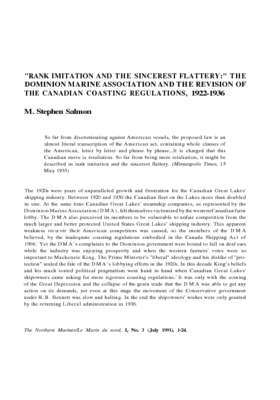Rank Imitation and the Sincerest Flattery: The Dominion Marine Association and the Revision of the Canadian Coasting Regulations, 1922-1936
- Publication
- The Northern Mariner / Le marin du nord (St. John's, NL), Jul 1991, p. 1-24
Description
- Creator
- Salmon, M. Stephen
- Media Type
- Website
- Text
- Item Type
- Articles
- Description
- The 1920s were years of unparalleled growth and frustration for the Canadian Great Lakes' shipping industry. Between 1920 and 1930 the Canadian fleet on the Lakes more than doubled in size. At the same time Canadian Great Lakes' steamship companies, as represented by the Dominion Marine Association ( D M A ) , felt themselves victimized by the western Canadian farm lobby. The D M A also perceived its members to be vulnerable to unfair competition from the much larger and better protected United States Great Lakes' shipping industry. This apparent weakness vis-a-vis their American competitors was caused, so the members of the D M A believed, by the inadequate coasting regulations embodied in the Canada Shipping Act of 1906.1 Y et the D M A ' s complaints to the Dominion government were bound to fall on deaf ears while the industry was enjoying prosperity and when the western farmers' votes were so important to Mackenzie King. The Prime Minister's "liberal" ideology and his dislike of "pro- tection" sealed the fate of the D M A ' s lobbying efforts in the 1920s. In this decade King's beliefs and his much touted political pragmatism went hand in hand when Canadian Great Lakes' shipowners came asking for more rigorous coasting regulations.2 It was only with the coming of the Great Depression and the collapse of the grain trade that the D M A was able to get any action on its demands, yet even at this stage the movement of the Conservative government under R . B . Bennett was slow and halting. In the end the shipowners' wishes were only granted by the returning Liberal administration in 1936.
- Date of Publication
- Jul 1991
- Subject(s)
- Language of Item
- English
- Copyright Statement
- Copyright status unknown. Responsibility for determining the copyright status and any use rests exclusively with the user.
- Recommended Citation
- The Northern Mariner/Le Marin du nord, I, No. 3 (July 1991), 1-24.
- Contact
- Canadian Nautical Research Society


